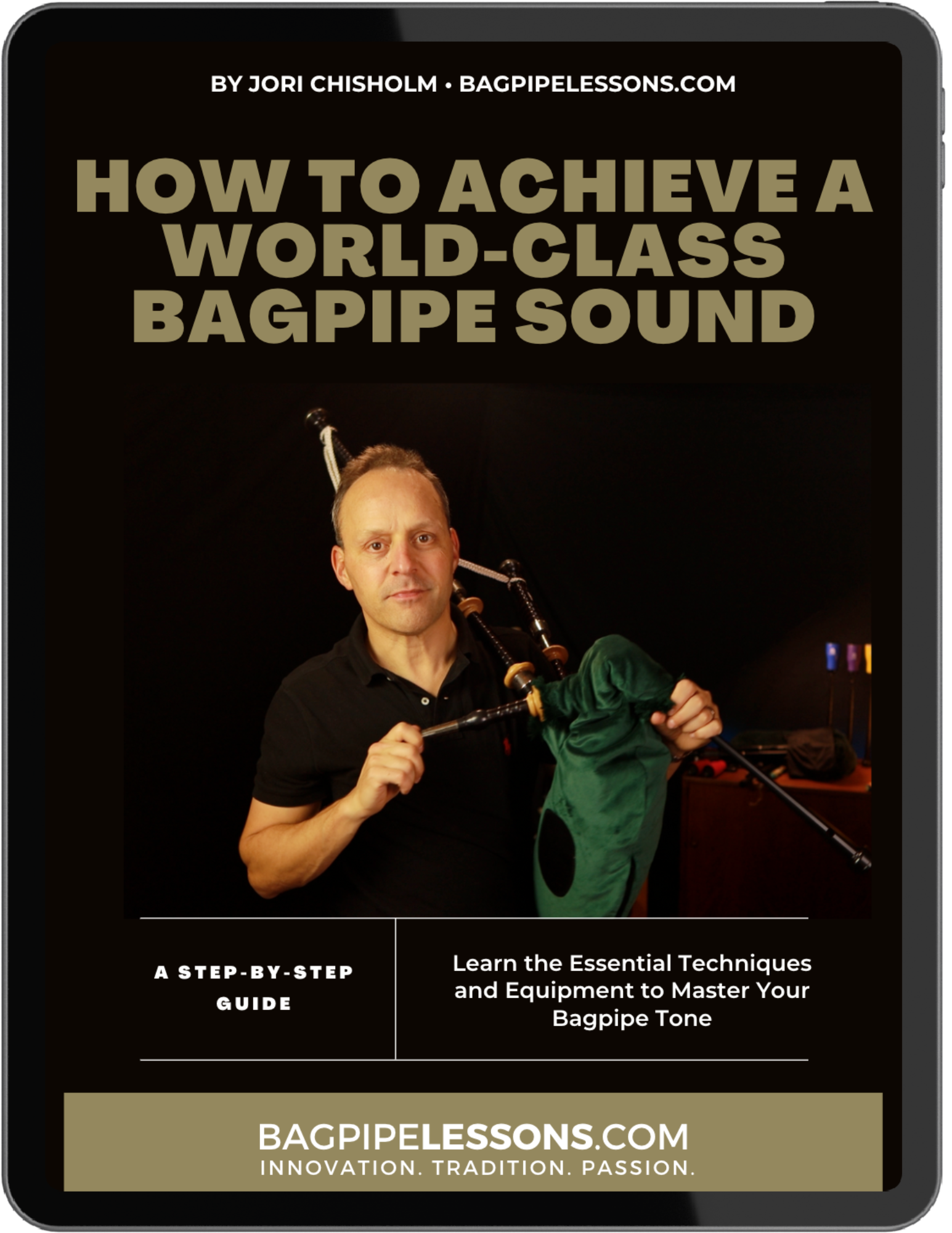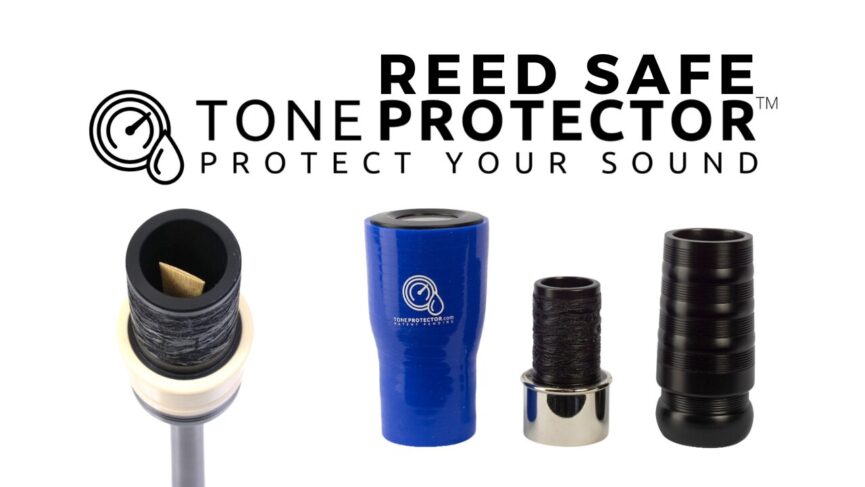
AS FEATURED IN

How to Master Steady Blowing: The #1 Skill Every Piper Needs for a Great Bagpipe Sound
by Jori Chisholm, Founder of BagpipeLessons.com
Last Updated: April 11, 2025
This video focuses on the essential skill every bagpiper needs for achieving a remarkable sound: mastering steady blowing. If you’re committed to enhancing your bagpipe sound to be full, rich, steady, and easy to tune, this video is your go-to resource.
We’ll explore what steady blowing truly means, its significance for unlocking your dream bagpipe sound, and the frequent mistakes pipers often make.
We’ll also introduce you to the Bagpipe Gauge, a tool designed specifically to improve your blowing strength and steadiness quickly. Say goodbye to inconsistencies and tune into a better bagpipe sound. Whether you’re an experienced piper or a beginner, the Bagpipe Gauge will help take your piping to the next level.
Watch the video and scroll down to read the full video transcript.
Video Transcript: Hello, Jori Chisholm here from BagpipeLessons.com. In this video we’re going to talk about using a Bagpipe Gauge to help improve your blowing and squeezing.
For those of you who don’t know, a Bagpipe Gauge is a simple device that measures the pressure inside of your bag. It’s a really valuable tool for helping you achieve a great sound on the bagpipes.
Before we dive into the specifics, I’d like to ask you to click the “like” button for this video, and also subscribe to my channel so you can see more videos like this one. So let’s dive right in.
The Bagpipe Gauge is a handy little tool that every piper should have in their toolbox. I designed this gauge specifically for my students, and I’ve been using it for years with great success. It’s simple to use and incredibly effective for refining your blowing and squeezing skills. The Bagpipe Gauge measures the pressure inside the bag in inches of water. On the gauge, you’ll see a small needle, which moves to indicate the pressure inside your bag as you play. This needle is your key to achieving a steady and controlled bagpipe sound.
The gauge attaches to your blowpipe stock and acts as a visual reference for your blowing and squeezing. It gives you immediate feedback on the steadiness of your bag pressure, helping you adjust your technique in real-time. One of the critical aspects of using a Bagpipe Gauge is maintaining a consistent bag pressure. When you play the bagpipes, you want your bag pressure to remain as steady as possible. A fluctuating pressure can result in a wavering, unsteady tone, which is something every piper wants to avoid.
By keeping an eye on the gauge’s needle, you can make real-time adjustments to your technique to ensure a consistent pressure level. It’s like having a pressure coach right there with you.
The first step in using a Bagpipe Gauge is to find your optimal high A pressure. Your high A note is a reliable reference point because it should be played with a relatively steady pressure. Start by playing your high A and watching the gauge’s needle. Make a mental note of the pressure level that maintains a good sound. This pressure is your target. Different bagpipes and reeds might require different high A pressures, so it’s essential to adjust it according to your specific setup. However, as a general guideline, a high A pressure around 25-30 inches of water is a good range to aim for.
Once you’ve found your ideal high A pressure, your goal is to keep your bag pressure as close to this level as possible during your entire practice session or performance.
Using the Bagpipe Gauge effectively requires you to focus on two key aspects of bagpipe playing: blowing and squeezing. Blowing is the process of supplying air to the bag. While playing, you must maintain the bag’s air pressure with steady and controlled breaths. Your goal is to keep the bag pressure steady and within a range of about five inches of water. Squeezing, on the other hand, involves regulating the airflow to the chanter and drones. When you squeeze the bag, you’re controlling the amount of air that reaches the reeds in the chanter and drones, directly affecting the pitch and tone of your playing. The critical aspect of squeezing is achieving consistency. The amount of pressure applied to the bag when squeezing should remain as constant as possible throughout your performance. If you squeeze too hard or not enough, it will result in variations in pitch and tone.
To maintain a steady bag pressure while playing, you must coordinate your blowing and squeezing. This coordination is key to achieving that sweet, locked-in sound that every piper strives for.
Remember, it’s the combination of steady blowing and squeezing that allows you to keep your bag pressure within the desired range. The Bagpipe Gauge serves as your visual guide, showing you exactly where your pressure level stands at any given moment.
Improving your Blowing & Squeezing Skills using the Bagpipe Gauge
To enhance your bagpipe playing, it’s essential to develop a keen sense of control over your blowing. You must learn how to maintain a consistent bag pressure, which means keeping the needle on the gauge steady as you play. This is where the gauge becomes your invaluable guide.
Start by playing a single note or drone while closely monitoring the gauge’s needle. As you play, focus on keeping the needle as steady as possible. Your goal is to avoid large fluctuations in pressure.
It’s quite common for pipers to experience fluctuations when they first start using the gauge. You might notice the needle moving up and down as you play. This is a natural part of the learning process. Don’t be discouraged; it’s an opportunity to refine your technique.
As you continue practicing with the Bagpipe Gauge, you’ll develop the muscle memory and control required to maintain a steady pressure. You’ll learn to adjust your blowing to keep the needle from fluctuating too much. The key to steady blowing is to find the right balance. You don’t want to overblow, causing the pressure to rise excessively, nor do you want to underblow, causing the pressure to drop too low. Instead, aim for that optimal range around your high A pressure.
One helpful exercise is to play a scale, paying close attention to the gauge’s needle. As you move through the scale, try to keep the needle within your target range. If you notice any significant deviations, focus on adjusting your blowing to bring it back into the desired range.
Squeezing, as mentioned earlier, is the other vital component of bagpipe playing. When you’re squeezing the bag, you’re controlling the airflow to the chanter and drones, which directly affects the pitch and tone of your playing.
Here’s a crucial point to remember: Squeezing should be coordinated with your blowing. The amount of air you supply through your blowing must match the amount you control through your squeezing. To improve your squeezing skills, consider practicing with just one or two drones active. This simplifies the process, allowing you to concentrate on those reeds. Start by playing a single drone and observe the gauge’s needle as you squeeze. Your goal is to maintain the bag pressure as steadily as possible, even when transitioning between notes.
To further refine your squeezing, focus on tuning your drones accurately. If your drones are well-tuned and steady, it’s an excellent indication that your bagpipe pressure control is in good shape. Remember, the Bagpipe Gauge is an exceptional tool for developing this skill. It provides you with real-time feedback, helping you identify areas where your pressure control needs improvement. It’s like having a personal bagpipe instructor guiding you as you play.
The gauge can also help you identify specific areas of your playing where your pressure control tends to falter. For instance, you might notice that your pressure drops when you’re executing embellishments or transitioning between notes. These insights are invaluable for targeted practice and improvement.
The process of learning to play the bagpipes effectively with a Bagpipe Gauge is akin to mastering any musical instrument. It takes practice, patience, and dedication to refine your technique. Don’t get discouraged if you don’t see immediate results. Over time, you’ll develop the muscle memory and control necessary to achieve that sweet, locked-in sound.
Practical Exercises & Concepts
The first thing you need to understand is that playing the bagpipes should be comfortable. If it feels physically taxing or painful, there’s a problem. Efficient bagpipe playing should not strain your body excessively. One of the critical aspects of comfortable playing is setting the bagpipe to the right pressure. This is where the gauge comes into play. The gauge helps you identify the ideal pressure for your setup. While the ideal pressure may vary slightly depending on your bagpipe, reeds, and individual preferences, you generally want to aim for a range of around 25-30 inches of water column.
High A is a key reference point for bagpipe pressure. The note High A serves as a useful indicator. When you’re blowing into the bag and playing High A, the gauge should show the optimal pressure for your setup. This is typically the point where the sound quality is excellent, and you’re not straining to maintain the note.
You don’t want the bag pressure to be too high, as this can lead to a shrill, unstable sound. Similarly, you don’t want it too low, as this can cause the sound to be flat or erratic. Additionally, your bagpipe should be easy to play in this pressure range. If you’re struggling to blow, it’s a sign that something is off. This could be due to factors like reed strength, bag seasoning, or equipment issues.
To ensure a comfortable playing experience, it’s essential to use the Bagpipe Gauge to help you find this sweet spot. Remember, you don’t have to be at the extreme ends of the pressure range; in fact, being on the lower end is often more comfortable.
You’ll find that experienced pipers aim for stability in their pressure. The gauge should not jump around wildly; instead, it should remain within a narrow range. This steadiness is what you’re aiming for.
The fluctuation in pressure should be minimal. The gauge’s needle might move slightly as you play, but this should not be a drastic or erratic change. A slight fluctuation is normal, but the goal is to keep it as steady as possible.
Your bagpipe should be set up to handle the desired pressure comfortably. Many pipers, especially beginners, tend to set their pipes at very high pressure, thinking that this will produce a better sound. In reality, it often leads to discomfort and poor tone. It’s a common misconception that high pressure equates to better sound. The goal is not to maximize pressure; it’s to achieve an ideal balance of pressure for your setup.
Remember that not all bagpipes are designed to handle extremely high pressure. The older pipes were not set up to be at that low pressure. There are players who prefer 35 or higher inches of water column. While some experienced players may have their reasons for this, it’s essential to avoid overly masochistic approaches. Playing at excessively high pressure can be physically challenging and uncomfortable, and it doesn’t necessarily lead to a better sound.
The truth is, modern bagpipes are designed with efficiency in mind. Reeds have improved significantly, and channels are designed to be efficient. This means you can achieve a great sound even with a comfortable reed and within a reasonable pressure range.
Your goal using the Bagpipe Gauge is total steadiness. If the pressure fluctuates within a range of about five inches, you’re doing well. A range of two inches is even better, and if the gauge consistently hovers around a single number, that’s an excellent outcome. This steadiness is what you’re aiming for.
Another crucial aspect to focus on is using the correct muscles when you’re blowing into the bag. You want to engage specific muscles to achieve controlled pressure. The key is to avoid overuse of the bicep muscles.
Blowing into the bag shouldn’t involve excessive bicep movement, which can lead to erratic pressure changes. You should primarily use your shoulder and upper back muscles to control bag pressure. Your forearm should be relatively steady without excessive movement, ensuring that the wrist remains neutral.
In terms of controlling the pressure using your arm, here’s a helpful exercise to isolate the proper muscles. Try this: while playing the high A, hold it steadily. Then, take your hand off the chanter while maintaining the high A note. Straighten your arm, and still, maintain the high A note. This exercise helps you focus on using the correct muscles. Your forearm shouldn’t exhibit any movement when you’re playing. This exercise also helps you identify the right muscles to control pressure while avoiding excessive wrist movement.
You can practice this exercise with the chanter plugged in, or you can use the drones. The goal is to strengthen the necessary muscles and establish a controlled, consistent pressure.
Potential Challenges in Mastering Steady Blowing
So now that you’ve learned about using the Bagpipe Gauge, finding the ideal pressure range for your setup, and the importance of steady blowing and the right muscle use, let’s continue discussing some blowing exercises and common challenges you might encounter.
The goal of these exercises is to help you progress from focusing solely on the gauge to playing full tunes while maintaining steady bagpipe pressure. It’s an incremental process, and it may not happen overnight, but with practice and dedication, you’ll improve your ability to maintain consistent pressure even when playing tunes.
First and foremost, remember that playing the bagpipes should be comfortable. If it feels physically taxing or painful, there’s an issue that needs to be addressed.
One of the most critical aspects of comfortable playing is setting your bagpipes to the right pressure. As mentioned earlier, the Bagpipe Gauge helps you determine this ideal pressure. While the exact number may vary based on your equipment and personal preferences, you typically want your bagpipes’ pressure to fall within a range of around 25-30 inches of water column.
High A is a critical reference point for bagpipe pressure. When you’re blowing into the bag and playing High A, the gauge should show the optimal pressure for your setup. This is the point where the sound quality is excellent, and you don’t have to strain to maintain the note.
You don’t want the pressure to be too high, which can lead to a shrill and unstable sound. On the other hand, you don’t want it to be too low, causing the sound to be flat or erratic.
Moreover, your bagpipe should be easy to play at this pressure. If you’re struggling to blow, it’s a sign that something is not right, possibly related to reed strength, bag seasoning, or other equipment issues. The gauge is your tool to help you find the right pressure for your setup, but it doesn’t have to be at the extreme ends of the pressure range.
Experienced pipers aim for stability in their pressure. The gauge should not show wild fluctuations. The needle might move slightly as you play, but this should be a gradual, small change, indicating that you’re maintaining steady pressure.
The fluctuation in pressure should be minimal. You may notice slight variations in pressure on the gauge as you play, but the key is to keep it as steady as possible. Steady pressure is the goal.
Your bagpipes should be set up to handle the desired pressure comfortably. It’s common for beginners to think that setting their bagpipes at very high pressure will produce a better sound. However, this often leads to discomfort and poor tone. High pressure doesn’t necessarily equate to a better sound. Instead, it’s about achieving an ideal balance of pressure for your setup, which allows for comfortable and efficient playing.
Your goal is to have a bagpipe setup that’s easy to play at the right pressure. Setting up your bagpipes with a lower and more comfortable pressure will help you play better and prevent physical discomfort. Your bagpipes should be designed to handle the pressure comfortably. Modern bagpipes are designed to be efficient, and the reeds have significantly improved. It’s essential to be in a pressure range that feels comfortable to you.
Experienced pipers tend to focus on pressure stability. While the needle on the gauge may move slightly as you play, this movement should be small and controlled. Wild fluctuations in pressure indicate issues in your technique or setup. Remember, the ideal pressure range can vary slightly depending on your setup. However, it’s better to aim for steadiness rather than extreme pressure.
The key concept is to have independent control over pressure and playing. The pressure in the bag should not be significantly affected by the tunes you play. It’s essential to decouple the pressure in the bag from the music’s tempo or the tunes you’re playing. You should maintain consistent pressure, irrespective of the musical context.
Playing the bagpipes should be comfortable and physically sustainable. You should aim to achieve consistent, steady pressure with minimal fluctuations while playing.
If you want to learn more about using the Bagpipe Gauge and enhancing your bagpipe skills, you can explore the BagpipeLessons.com Inner Circle, where you can access live group classes, a library of lessons and videos, and personalized support.





